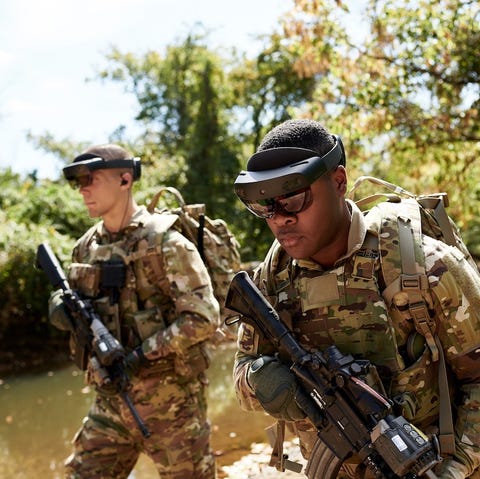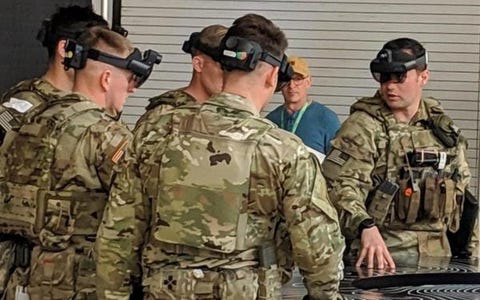By Kyle Mizokami
 The U.S. Army, using Microsoft’s Hololens, has developed new goggles to help soldiers on the battlefield.
The U.S. Army, using Microsoft’s Hololens, has developed new goggles to help soldiers on the battlefield.
IVAS will put data in a soldier’s field of view, allowing wearers to maintain situational awareness while interacting with the system.
The system will eventually allow soldiers to fire their weapons without seeing the enemy.
The U.S. Army is planning to buy 40,000 pairs of 'mixed reality' goggles, enough to outfit nearly one in ten soldiers. The IVAS goggles, derived from Microsoft’s Hololens program, will allow soldiers to identify friendly and enemy forces and aim their weapons without directly seeing the enemy. Soldiers will be better informed and able to trade fire on the battlefield while benefiting from better cover and protection.

Soldiers perform an after-action review through their IVAS devices after navigating through a shoot house.
PEO SOLDIER/DVIDS
The Integrated Visual Augmentation System, or IVAS goggles were developed from Microsoft’s Hololens 2 "mixed reality” system. Hololens is basically a consumer helmet mounted display similar to those worn by fighter pilots, projecting data into the field of view of the goggles wearer. Hololens was released in 2016 and runs on Microsoft’s Windows 10 operating system.
The U.S. Army has spent more than a decade trying to figure out how soldiers in the field can benefit from the so-called information revolution. Early efforts involved PDAs, smartphones, and even tablets, all of which failed for one reason or another. One major reason was that it was a distraction to fire up a smartphone during combat and then use the interface to figure out where friendly units were. And other tasks, like sighting a weapon, were a non-starter.
MORE FROM POPULAR MECHANICS
IVAS goggles, on the other hand, allow the user to maintain his or her situational awareness while interacting with the device. A soldier can continue to scan a hillside for enemy movement while using the Hololens goggles.
The final product coming in late 2021 will include: a color see-through digital display that makes it possible for the user to access information without taking his eye off the battlefield; thermal and low-light sensors that make it possible to see in the dark, literally; rapid target acquisition and aided target identification; augmented reality and artificial intelligence, to name just a few.

One entrant in the Next Generation Squad Weapon system program. The IVAR-associated optic would look much different than this.
More abilities, such as facial recognition, may eventually be rolled into the system. One possible killer app for IVAS is future integration with the Next Generation Squad Weapon systems, which will replace the M4 carbine and the M249 Squad Automatic Weapon. Soldiers will be able to “see” through the sights of their IVAS goggles to aim and fire their weapons. A soldier would be able to hold her rifle out around the corner of a building, never physically laying eyes on the target but able to see the target through IVAS and open fire.
According to the Army Times, the U.S. Army plans to ultimately buy 40,000 sets of IVAS goggles, enough for those in the combat arms branches, combat engineers, and U.S. Army special operations forces.
No comments:
Post a Comment